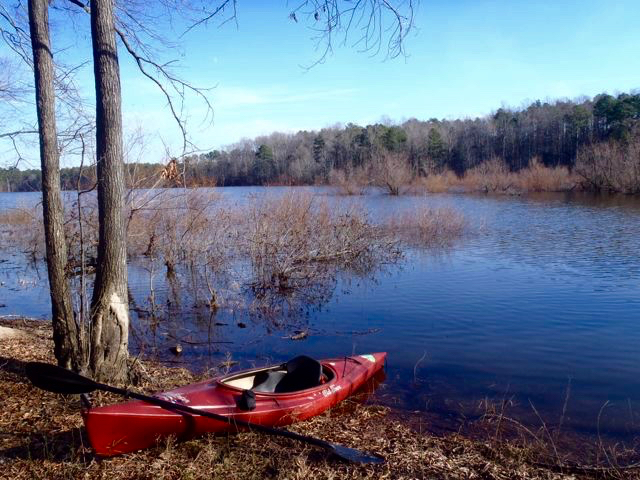
Two things typically cause us to put up the kayaks and canoes come November: water temperature and air temperature. No one wants to flip the boat when there’s a chance the Big Chill might set in.
But as we noted in our last post, the water temperature at Falls Lake north of Raleigh was still above 70 degrees on Nov. 3, while the average daytime high for the month is 62.4. Not balmy, certainly. But not freeze-off-beloved-body-parts cold, either. That said, here’s our pitch for where to paddle during the penultimate month of the year.
Open water. You know how the idea of paddling on a lake seems great during the summer — until you actually get out on the exposed expanse and melt like WWW? In November, you’ll relish those wide open spaces on a sunny day when the temperature is in the 60s.
Immediately, some of the region’s big lakes come to mind: Falls and Jordan in the Triangle; Townsend, Brandt and Higgins in the Triad; Norman north of Charlotte. For some paddlers, that big water conjures images of big waves whipped up by the motor boat crowd. You’ll want to eschew the more open stretches of water in favor of the more intimate fingers that lead from the creeks that feed these water projects. They aren’t hard to find: get a map (Google Maps will do), find these narrower waterways, then find the nearest boat access. And worry not that speedboats aplenty will be using these access points as well: they’ll likely make a beeline for more open water, you’ll head directly for those beckoning fingers.
For instance: At Jordan Lake, the Ebenezer Church Boat Ramp off Beaver Creek Road offers speedy access to much of the lake. The savvy paddler, however, immediately goes east under the Beaver Creek Road Bridge and discovers two lengthy fingers that offer access to the wetlands of Beaver Creek and Little Beaver Creek.
Dam-controlled rivers. Why dam controlled? Because November happens to be the second driest month of the year and these rivers are where you’re mostly likely to find water deep enough to paddle as lake levels are lowered to make room for winter rains. Good options in the Piedmont include the Neuse, Yadkin, Dan and Cape Fear rivers. You can make sure there’s enough water — and not too much — by monitoring the USGS gauges for these rivers, here. Find out what those gauge numbers mean in terms of paddling with Paul Ferguson’s “Paddling Eastern North Carolina.” Also use Ferguson’s book to find river access points on these and other rivers in eastern N.C. Like river paddling but not the shuttle? Check for where a river empties into a dammed lake: the water will be slow moving — slow enough that you should be able to paddle upstream for a bit.
For instance: From the Eno River Boat Ramp off Red Mill Road in Durham County, you can put in and paddle upstream almost to Penny’s Bend.
Coastal waters. Our favorite paddling this time of year are the waters of the coastal plain and coast. There’s nearly always water, it tends to be a bit warmer Down East, but not warm enough to arouse th flying pest population. And, you can still find some open boat rentals in the region if you don’t have a canoe or kayak of your own.
For instance: At Merchants Millpond State Park you may rent a canoe for $5 an hour. This is good for three reasons: one, $5 an hour is rather reasonable; two, they rent Old Town 158 canoes (a most friendly paddle craft); and three, the 760-acre millpond, pocked with ancient bald cypress and tupelo gum, is one of the most stunning paddles around. November park hours are 8 a.m. to 6 p.m.
Get your paddle, get paddling.
* * *
Resource
For more information on paddling in cooler weather, on places to paddle, and on all sorts of other paddle-related stuff, check out our GetPaddling! Resource Page.
